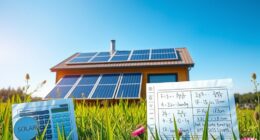When choosing eco-friendly insulation materials, focus on options made from renewable or recycled resources, like sheep’s wool or recycled cellulose. These materials support sustainable sourcing, reduce VOC emissions, and improve indoor air quality. They also provide excellent thermal resistance, helping you save on energy costs while maintaining comfort. Supporting responsible manufacturing practices further benefits the environment. To discover more about selecting the best eco-friendly options for your home, keep exploring available choices and their benefits.
Key Takeaways
- Select insulation made from renewable or recycled materials like cellulose, wool, or cotton to reduce environmental impact.
- Prioritize low-VOC or VOC-free options to improve indoor air quality and promote healthier living spaces.
- Opt for highly energy-efficient insulations with high R-values to enhance home comfort and lower energy bills.
- Choose products from manufacturers committed to sustainable sourcing and environmentally responsible production practices.
- Consider ease of installation and maintenance to ensure long-term performance and environmental benefits.

When selecting insulation for your home, opting for eco-friendly materials not only benefits the environment but also improves indoor air quality and energy efficiency. One of the key factors to consider is sustainable sourcing. Eco-friendly insulation materials are typically derived from renewable resources or recycled content, reducing the strain on natural ecosystems. For example, cellulose insulation made from recycled paper or wool insulation sourced from sheep ensures that the raw materials are replenished and harvested responsibly. By choosing products with certified sustainable sourcing, you help promote environmentally conscious manufacturing practices, which in turn reduces your home’s carbon footprint.
Choosing eco-friendly insulation supports sustainable sourcing and reduces your home’s carbon footprint.
In addition to environmental benefits, sustainable sourcing directly impacts indoor air quality. Many traditional insulation materials release volatile organic compounds (VOCs) over time, which can compromise indoor air and pose health risks. Eco-friendly options, on the other hand, are often manufactured without harmful chemicals, making them safer for your family. Materials like cotton or wool are naturally hypoallergenic and emit fewer pollutants, creating a healthier living environment. When you prioritize insulation with certified low-VOC emissions, you’re supporting a healthier indoor atmosphere and reducing potential respiratory issues caused by airborne toxins.
Energy efficiency is another critical consideration. Proper insulation reduces heat loss in winter and keeps your home cooler during summer, which can substantially lower energy bills. Eco-friendly insulations often have high thermal resistance values and superior air sealing properties, ensuring your home stays comfortable year-round. Natural materials like sheep’s wool also have moisture-wicking properties that help maintain ideal indoor humidity levels, preventing mold growth and further improving indoor air quality. When you select insulation with these qualities, you’re investing in a solution that minimizes energy consumption and enhances overall home comfort.
Choosing insulation made from sustainable sources also encourages manufacturers to adopt greener production processes. Many eco-friendly products are produced using renewable energy and environmentally responsible methods, which further decreases environmental impact. By supporting these practices, you contribute to a more sustainable industry and help foster innovation in eco-conscious building materials.
Furthermore, advancements in insulation technology have led to the development of materials that not only provide excellent thermal performance but are also easier to install and maintain, ensuring long-term sustainability. Ultimately, your choice of insulation impacts not just your energy bills but also your health and the environment. Prioritizing options with sustainable sourcing and low VOC emissions can make a meaningful difference. You’ll enjoy a more comfortable, healthier home while actively reducing your ecological footprint. When you opt for eco-friendly insulation, you’re making a smart decision that benefits everyone—your family, your wallet, and the planet.
Frequently Asked Questions
How Do Eco-Friendly Insulation Materials Compare in Cost to Traditional Options?
Eco-friendly insulation materials generally cost more upfront than traditional options, but their affordability analysis shows long-term savings through energy efficiency. You might pay a bit more initially, but you’ll benefit from lower utility bills and reduced environmental impact. The cost comparison varies depending on the material, but investing in eco-friendly choices often proves to be a smart, cost-effective decision over time, especially when considering sustainability and energy savings.
Are Eco-Friendly Insulations Effective in Extreme Weather Conditions?
Like a brave hero facing the storm, eco-friendly insulations prove their worth in extreme weather. You’ll find they offer impressive thermal performance, helping maintain consistent indoor temperatures. Although installation challenges may arise—similar to steering through rugged terrain—you can overcome them with proper guidance. Rest assured, these sustainable materials are effective, providing reliable insulation that shields your home from harsh elements, just like a trusty shield in a fierce battle.
What Are the Long-Term Environmental Impacts of Various Insulation Materials?
You should consider that eco-friendly insulation materials often have recyclability concerns, making it hard to repurpose or dispose of them sustainably. Additionally, biodegradability challenges mean some materials may not break down easily, potentially harming the environment over time. While they reduce initial impacts, long-term effects vary; some might require special disposal methods, so understanding these impacts helps you make better decisions for a greener future.
Can Eco-Friendly Insulation Improve Indoor Air Quality Significantly?
You might notice a real difference in your indoor air quality with eco-friendly insulation. These materials actively reduce indoor pollutants by preventing mold growth and off-gassing from synthetic substances. Imagine breathing easier, knowing that your insulation helps filter out allergens and volatile organic compounds. This translates into healthier air, fewer respiratory issues, and a more comfortable living environment. Eco-friendly insulation truly enhances air quality benefits for your home and your well-being.
How Should I Dispose of or Recycle Eco-Friendly Insulation Materials?
You should check local recycling options and disposal methods for eco-friendly insulation materials. Many communities accept cellulose or mineral wool for recycling, but always verify with your local waste management. If recycling isn’t available, follow the manufacturer’s disposal instructions carefully to guarantee safe and environmentally responsible disposal. Avoid landfilling whenever possible, and consider donating unused materials to minimize waste and promote sustainability.
Conclusion
Just like Robin Hood chose to protect the forest, you can choose insulation that safeguards the environment. By selecting eco-friendly materials, you’re not only improving your home’s energy efficiency but also playing a part in preserving our planet’s future. Remember, small choices today echo like ripples through history—shaping a greener, more sustainable world for generations to come. Make the conscious choice, and be a hero for the Earth, just like those legendary guardians of nature.









